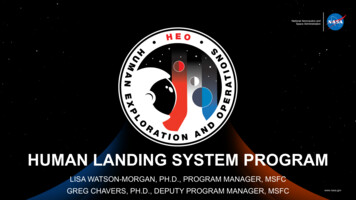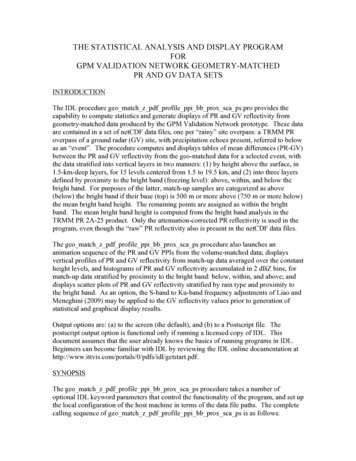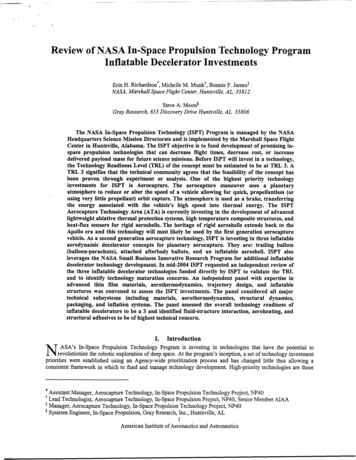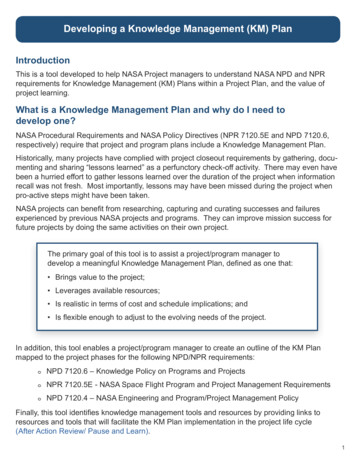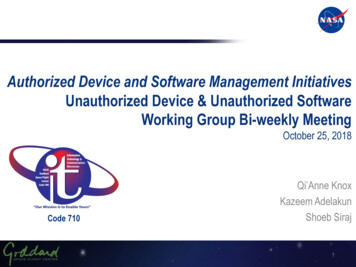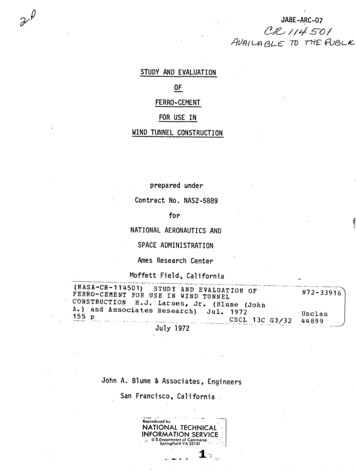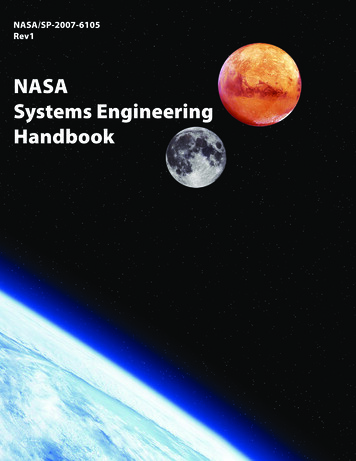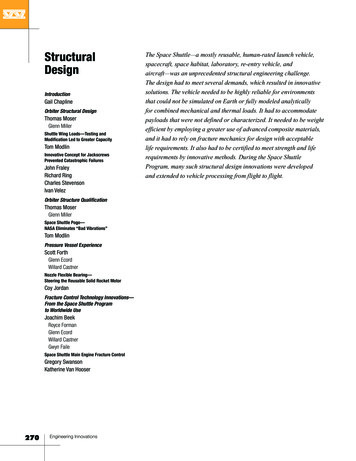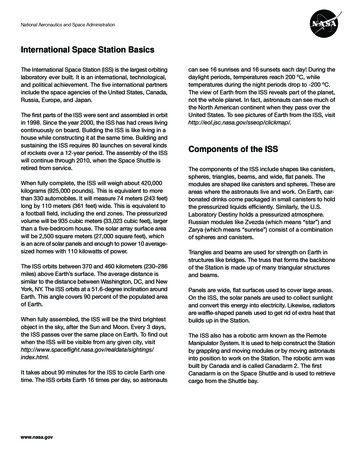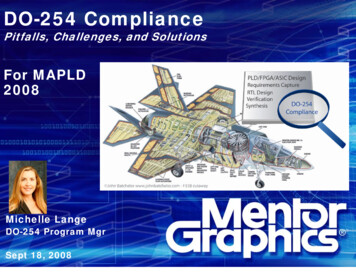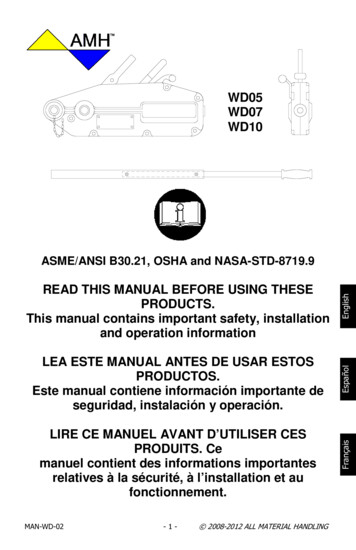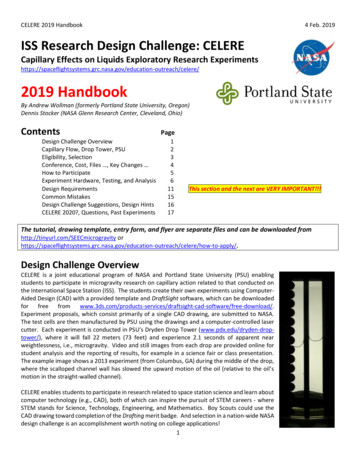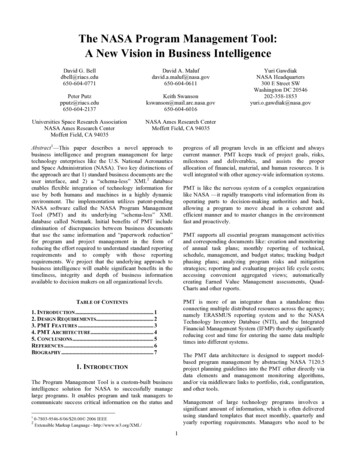
Transcription
The NASA Program Management Tool:A New Vision in Business IntelligenceDavid G. Belldbell@riacs.edu650-604-0771David A. Malufdavid.a.maluf@nasa.gov650-604-0611Peter Putzpputz@riacs.edu650-604-2137Keith rsities Space Research AssociationNASA Ames Research CenterMoffett Field, CA 94035NASA Ames Research CenterMoffett Field, CA 94035Yuri GawdiakNASA Headquarters300 E Street SWWashington DC ��This paper describes a novel approach tobusiness intelligence and program management for largetechnology enterprises like the U.S. National Aeronauticsand Space Administration (NASA). Two key distinctions ofthe approach are that 1) standard business documents are theuser interface, and 2) a “schema-less” XML2 databaseenables flexible integration of technology information foruse by both humans and machines in a highly dynamicenvironment. The implementation utilizes patent-pendingNASA software called the NASA Program ManagementTool (PMT) and its underlying “schema-less” XMLdatabase called Netmark. Initial benefits of PMT includeelimination of discrepancies between business documentsthat use the same information and “paperwork reduction”for program and project management in the form ofreducing the effort required to understand standard reportingrequirements and to comply with those reportingrequirements. We project that the underlying approach tobusiness intelligence will enable significant benefits in thetimeliness, integrity and depth of business informationavailable to decision makers on all organizational levels.progress of all program levels in an efficient and alwayscurrent manner. PMT keeps track of project goals, risks,milestones and deliverables, and assists the properallocation of financial, material, and human resources. It iswell integrated with other agency-wide information systems.TABLE OF CONTENTSPMT is more of an integrator than a standalone thusconnecting multiple distributed resources across the agency;namely ERASMUS reporting system and to the NASATechnology Inventory Database (NTI), and the IntegratedFinancial Management System (IFMP) thereby significantlyreducing cost and time for entering the same data multipletimes into different systems.PMT is like the nervous system of a complex organizationlike NASA —it rapidly transports vital information from itsoperating parts to decision-making authorities and back,allowing a program to move ahead in a coherent andefficient manner and to master changes in the environmentfast and proactively.PMT supports all essential program management activitiesand corresponding documents like: creation and monitoringof annual task plans; monthly reporting of technical,schedule, management, and budget status; tracking budgetphasing plans; analyzing program risks and mitigationstrategies; reporting and evaluating project life cycle costs;accessing convenient aggregated views; automaticallycreating Earned Value Management assessments, QuadCharts and other reports.1. INTRODUCTION . 12. DESIGN REQUIREMENTS. 23. PMT FEATURES . 34. PMT ARCHITECTURE . 45. CONCLUSIONS . 5REFERENCES . 6BIOGRAPHY . 7The PMT data architecture is designed to support modelbased program management by abstracting NASA 7120.5project planning guidelines into the PMT either directly viadata elements and management monitoring algorithms,and/or via middleware links to portfolio, risk, configuration,and other tools.1. INTRODUCTIONThe Program Management Tool is a custom-built businessintelligence solution for NASA to successfully managelarge programs. It enables program and task managers tocommunicate success critical information on the status and12Management of large technology programs involves asignificant amount of information, which is often deliveredusing standard templates that meet monthly, quarterly andyearly reporting requirements. Managers who need to be0-7803-9546-8/06/ 20.00 2006 IEEEExtensible Markup Language - http://www.w3.org/XML/1
2. DESIGN REQUIREMENTSable to gather and understand large amounts of businessinformation in busy meetings have a vital interest in thestandardization of report formats. Therefore, information isnot only required based on templates, but also required inthe format of specific software packages such asMicrosoft Excel, Microsoft Word, Microsoft Powerpoint and Adobe Acrobat . While the source ofthis information is often found in multiple databases withmultiple schemas, and the destination of this informationoften goes to multiple databases with multiple schemas, thehuman readable format is most critical since managementdecisions are typically based on conversations andexchanges between humans not machines. Standard formatsare required for exchanges between technical experts anddecision-making authorities in order for the decisionmaking authorities to make informed choices using comparable information across the portfolio of selected projects.For the management of large technology programs theintegration of heterogeneous and distributed technologyinformation is required, and is feasible with moderninformation technologies. Heterogeneous informationinvolves diverse data structures in structured databases, andunstructured information stored in spreadsheets, wordprocessing documents, presentations and other formats usedfor human analysis and communication. In the end, it ishumans who make management decisions, so this is not justan integration challenge, but also a challenge of composinginformation from heterogeneous sources for use in humancommunication and decision-making.A key to addressing the data heterogeneity issue is theadoption and enforcement of standards across informationsystems. While XML is clearly emerging to be the linguafranca for databases and internet systems, it is encouragingto see the enforcement of standards even at the level ofMicrosoft Word and Microsoft Powerpoint documents. For instance in the NASA enterprise the newESR&T3 program has explicitly specified the requirementsand formats for monthly project reports. Each project isrequired to submit a monthly progress report, in accordancewith its approved project plan or contract Statement ofWork, that provides information on the progress of theproject during the previous month, in the areas of technicalaccomplishments, status against schedule, spending,performance against Earned Value Management metrics,planned activities for the following month, and otherinformation pertinent to the tracking and management of theproject. The formats have been specified for Word andPowerpoint documents which will be the reporting formatsfor this program.Integrated business intelligence is an approach that not onlyenables automated exchange of information betweenmachines, but also enables automated use of standardbusiness documents, spreadsheets and presentations that arean integral part of the exchange of information betweenhumans for decision making. Business documents becomethe user interface, and information entered once in businessdocuments gets automatically aggregated and repurposedinto standard outputs for use by both humans and machines.This approach is enabled by patent-pending softwaredeveloped at the U.S. National Aeronautics & SpaceAdministration (NASA), including a novel document-basedprogram management application and its novel underlying“schema-less” XML database.Key distinctions of the approach are:(1)(2)Standardized business documents are a key userinterface (spreadsheets, presentations, documents),eliminating the need for information administration byautomating the communication of information usingstandard templates, andThe key capabilities that thus must be incorporated in aneffective program management information system for anenterprise such as NASA are summarized as follows:A 'schema-less' XML database enables integration andquery-based document composition, eliminating theneed for database administration by automating theintegration of information that have diverse schemas.A key breakthrough of this approach is that the use ofbusiness documents as the inputs and outputs of themanagement system enables transparency up and down themanagement chain. Project managers can see how theirproject information gets summarized in the diversity ofpresentations and documents used by program managers.Program managers can also see the more detailed projectinformation beyond the project summaries they normallyreceive. This approach eliminates discrepancies betweenmultiple documents that use the same project information,since the multiple project documents are automaticallycreated from the XML stechnology databases in a consistent manner, forexample project, program and enterprise-leveltechnology databases; past, current, and futuretechnology databases; technical, managerial andfinancial databases.(2)Composing analyses and reports from heterogeneoustechnology databases in support of diverse technologymanagement processes, such as gap analyses,technology assessments, and technology roadmaps;and, historical problem/failure trend reports,bug/requirements tracking, concept/feature tracking.(3)Communicating technology information among diversetechnology development stakeholders and technologydatabase systems in order to assess data pedigree and32Exploration systems research and technology
support effective decision making for diverseorganizational processes, such as project and programmanagement, internal and external reviews, intellectualproperty and investment management, gap analysesand technology forecasting; and diverse databasesystems.documents to a local desktop. They can be edited withconventional spreadsheet software and uploaded to PMT bythe push of a button. Figure 2 provides an illustration of atypical input document:3. PMT FEATURESPMT has been developed to meet the above mentionedrequirements and the vision of a business intelligencesolution that enables humans to communicate efficientlyacross organizational boundaries by seamlessly integratingheterogeneous data sources. The two key distinctions of theapproach to integrated business intelligence incorporated inPMT are: 1) standardized business documents as a key userinterface, and 2) a “schema-less” XML database enablesintegration. These key features distinguish PMT from anentire category of existing project and program managementtools that are commercially available.Figure 2 – Spreadsheet as PMT InputAt NASA input documents such as Task Plans and Monthlyreports are typically in formats such as Microsoft Excel,Microsoft Word, Microsoft Powerpoint and Adobe Acrobat since they can be easily distributed by email.PMT users just take the spreadsheets, presentations, andreports that they use in their day-to-day activities to inputdata into the PMT system. This input process is extremelysimple, typically requiring users to upload informationthrough a web server, or simply drag and drop documentsinto (Web DAV 4) folders on the desktop. The input data isautomatically converted into XML and stored in a highthroughput information management system (discussed indetail in the Technical Details section).PMT can automatically generate aggregated documentsfrom several input documents from multiple programs, veryquickly. For instance PMT has been used to automaticallygenerate NASA IBPDs (Integrated Budget PerformanceDocuments) spreadsheets using rollup approaches, thussaving significant time and eliminating budget errors. Thedetails and benefits are discussed further in the conclusionssection. Other examples of the aggregated documents areintegrated budget/cost reports or summary Quad-Charts thatcan be automatically created by PMT.Figure 1 – PMT PortalThe design philosophy of PMT has been to develop apowerful program management information system whileproviding a simple and intuitive user interaction throughstandardized business documents in all stages of theprogram management lifecycle. PMT supports all essentialprogram management activities and correspondingdocuments such as creation and monitoring of annual taskplans; monthly reporting of technical, schedule,management, and budget status; tracking budget phasingplans; analyzing program risks and mitigation strategies;reporting and evaluating project life cycle costs; accessingconvenient aggregated views; and automatically creatingQuad-Charts and other reports. It is a comprehensive, webenabled tool which provides an intuitive and enhanced webinterface for all user activities from setting up the basicprogram configuration, to creating reports and charts.Alternatively, data input can be easily done off-line bydownloading annual task plans, monthly reports and otherPMT is also interfaced and interoperable with existingNASA information systems. For instance it is connected tothe ERASMUS5 reporting system and to the NASATechnology Inventory6, thereby significantly reducing costand time for entering the same data multiple times intodifferent systems.4Discussed shortlyhttp://www.hq.nasa.gov/erasmus/splash nasa.htm : A NASA projectperformance dashboard6http://inventory.gsfc.nasa.gov/ : Database of NASA ongoing technologyactivities53
Figure 3 – PMT Document WorkflowIn essence, PMT acts like the nervous system of a complexliving organism—it rapidly transports vital informationfrom its operating parts to decision-making authorities andback, allowing a program to move ahead in a coherent andefficient manner and to master changes in the environmentfast and proactively.At the heart of PMT is a high-throughput informationi
management, and budget status; tracking budget phasing plans; analyzing program risks and mitigation strategies; reporting and evaluating project life cycle costs; accessing convenient aggregated views; and automatically creating Quad-Charts and other reports. It is a comprehensive, web-enabled tool which provides an intuitive and enhanced web
